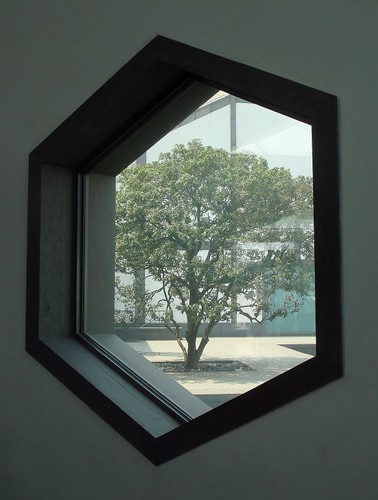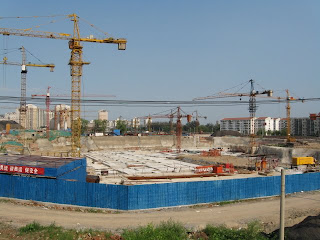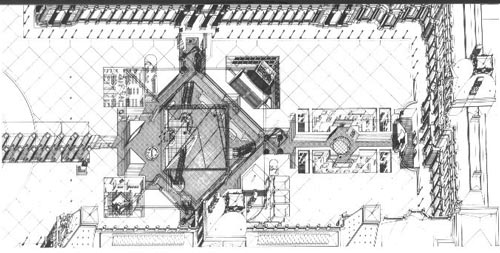Construction on the Suzhou Museum is finally completed! What a success! This project has been a literal work of history from the beginning and I am so pleased with the end result! This truly is one of the most monumental moments of my career. This is not just a building I designed, it is a tribute to China, it is a way of bringing some of the most pivotal moments in China's cultural history to it's modern citizens. This museum has helped me recognize who I am as a Chinese native and has also allowed me to solidify my position as a Chinese artist.
Front view of the Suzhou Museum
Although very modern and even somewhat unusual in design, the Suzhou museum is clearly a Chinese structure. The concepts that guide traditional Suzhou and Chinese architecture (centered on symmetry, contrast, distinct lines and geometry) were easily adapted into "modern" building design. The modernist style also focuses on lines, symmetry and geometry. Its amazing how well the two styles paralleled and almost lead into one another. Looking at this building one of the first things you notice is its colors. White washed walls with a dark gray framing outlining each section of wall. This dramatic contrast is just one simple technique pulled from early Chinese are and architecture. Early painters regarded color and shadow as a distraction in their works and thus primarily worked in black ink. The design, light on dark with large expanses of blank space, connect with these early painting principles and give the impression that the structure has been drawn with the dark lines of a Chinese brush stroke.
Looking at the front entrance another technique becomes apparent. Exact symmetry. I am not the first architect to employ this idea, and the concept is not as "modern" as one may think. I know I've discussed symmetry before so I'll keep my analysis short. Perfect symmetry has been a highlight of Chinese architecture for centuries, emphasizing balance and order and this idea seen through out the museum.
I used other traditional shapes in my design, some more subtle than others. Although not blatantly obvious, this outdoor gazebo has some definite markers of a pagoda (I felt the need to add this into the museum plan since Suzhou is know for bridges, gardens and pagodas. If you look closely there are a few very understated bridges navigating the waters around the garden.) The multi-layered roof, its overhangs emphasized more than most modern style buildings gives a uniquely Chinese feel to the outdoor room. The gazebo is complete with a mast, found decorating the top of many Buddhist shrines and a version of the umbrella (the decorative addition on the mast). The structure it's self holds true to the use of symmetry and contrast in it's framing and support.
As I said before, staying true to the markers of Suzhou, I have included several masonry bridges in the museum's design. The feeling that one is looking at some version of a classic Chinese bridge is no accident. The railing detail (all though small) was inspired by the wooden outlines of many older more traditional bridges. A few things I do want to point out, some significant differences between the structure I have designed and traditional buildings, are the lack of color which was so widely used in the classic Chinese structures and the missing intricate detail of railings and accents. Reds and golds (imperial colors) are used widely through out China even today. It is obvious when looking at many examples of pottery and architecture that the Chinese valued color in their daily lives (note however that in many ancient paintings color was excluded). Suzhou is comprised of many buildings that have adopted a white washed exterior, probably because many of the Scholars that influenced Suzhou's development had abandoned the government and all it's identifiers when foreigners infiltrated and ultimately took over China. Not that I'm trying to make a political statement with my museum, but I agree with the separation of art and politics and decided to carry on this tradition by excluding colors from the building.
The other exclusion I chose to make was that of the intricate detail so often seen in the wood, windows and accents of many traditional enclosures. Although I did want to stay true to the classic traditions, I am, at heart, a modernist designer. Less is more and i really feel that with the more simplistic composition of the walls of this building that it's roots in tradition can be more easily recognized. If you notice the roof of the building, it does use the classic tile detail that most buildings of the era boast. This was a small detail that I did like very much (both for it's form and functionality) that I chose to bring into my modern design.
I'm very pleased with the final design. I have contributed my own newly introduced concepts to the centuries old traditions built in china and I truly believe that many scholars wanted this type of contribution to happen in order to move art forward. I used more modern and even slightly unorthodox materials (concrete, fiberboard, etc.), I put my own artistic interpretations on the core design principles of symmetry and balance, and used my training as a "modern" designer to simplify traditionally intricate accessories.
I'm very pleased with the final design. I have contributed my own newly introduced concepts to the centuries old traditions built in china and I truly believe that many scholars wanted this type of contribution to happen in order to move art forward. I used more modern and even slightly unorthodox materials (concrete, fiberboard, etc.), I put my own artistic interpretations on the core design principles of symmetry and balance, and used my training as a "modern" designer to simplify traditionally intricate accessories.
The Suzhou Museum is set to open to the public next year (in 2007)! Please, come visit and enjoy China's history and feel the connection between today and the country's vivid past as I have during these past few years.





































